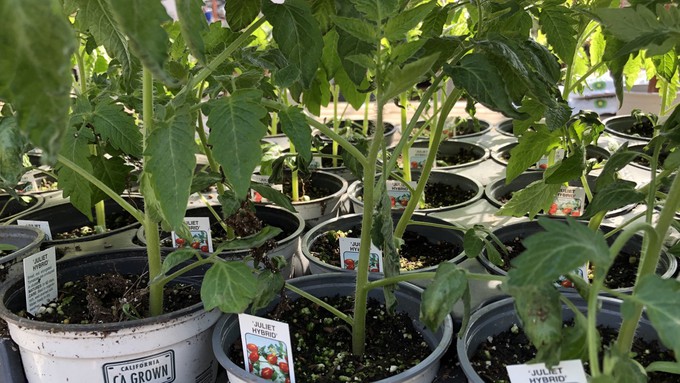
Wait until soil temperature warms to 65 degrees

These Juliet tomatoes are just the right size for planting -- if it were April. As it is, February is too cold, yet the seedlings were already on display for sale this past Wednesday. Kathy Morrison
Is it too early to plant tomatoes? Yes! It’s mid-February and still winter, no matter the daytime air temperature or how much sun. Ignore those tomato seedlings now showing up in nurseries; if planted in the ground now, they’ll only suffer.
But to know for sure about tomato planting time, feel your soil. More specifically, measure its temperature.
Soil thermometers, available at nurseries, are a handy tool that will prevent costly planting mistakes. Know which seeds and tender transplants need soil temperature-wise before condemning them to a frosty demise.
Right now, our soil is too cold for even cool-season crops to get comfortable. According to UC Davis’ weather stations, soil temperature at its Russell Ranch test site on Friday afternoon (Feb. 17) was 46.3 degrees, measured about 8 inches below the surface; 46.5 degrees about 4 inches down. Cool-season vegetables such as beets and lettuce need 50-degree soil for root development and growth. When soil is too cold, the seed can rot before it sprouts.
Tomatoes, peppers and other summer crops require soil at least 60 degrees to get started; they’ll still just sit there and not really grow, but at least their roots won’t feel like they’re freezing. To get off to a strong start, tomatoes prefer at least 65-degree soil when transplanted.
And that’s almost 20 degrees warmer than our soil is now.
When will our soil reach 65 degrees? Most likely in mid to late April, our traditional tomato planting time.
In the meantime, if you've already succumbed to the lure of those tomato seedlings, any plants that look ready to go into the ground can be transplanted into 1-gallon black plastic pots. Line the pots with several sheets of newspaper for extra warmth and insulation before filling with potting mix. The black plastic will absorb heat and help root development inside the pot – while our native soil remains cold for several more weeks.
In their cozy black pots, baby tomato plants can grow strong and develop a sturdy rootball. Once their future planting bed warms up into the 60s, transplant the seedlings – with rootballs intact – into their summer homes.
For a look at UC Davis’ weather station reports and soil temperature: https://atm.ucdavis.edu/weather/uc-davis-weather-climate-station/.
Comments
0 comments have been posted.Sacramento Digs Gardening to your inbox.
Food in My Back Yard Series
May 6: Maintain soil moisture with mulch for garden success
April 29: What's (already) wrong with my tomato plants?
April 22: Should you stock up on fertilizer? (Yes!)
April 15: Grow culinary herbs in containers
April 8: When to plant summer vegetables
April 1: Don't be fooled by these garden myths
March 25: Fertilizer tips: How to 'feed' your vegetables for healthy growth
March 18: Time to give vegetable seedlings some more space
March 11: Ways to win the fight against weeds
March 4: Potatoes from the garden
Feb. 25: Plant a fruit tree now -- for later
Feb. 18: How to squeeze more food into less space
Feb. 11: When to plant? Consider staggering your transplants
Feb. 4: Starting in seed starting
Sites We Like
Garden Checklist for week of May 11
Make the most of the lower temperatures early in the week. We’ll be back in the 80s by Thursday.
* Plant, plant, plant! It’s prime planting season in the Sacramento area. Time to set out those tomato transplants along with peppers and eggplants. Pinch off any flowers on new transplants to make them concentrate on establishing roots instead of setting premature fruit.
* Direct-seed melons, cucumbers, summer squash, corn, radishes, pumpkins and annual herbs such as basil.
* Harvest cabbage, lettuce, peas and green onions.
* In the flower garden, direct-seed sunflowers, cosmos, salvia, zinnias, marigolds, celosia and asters. (You also can transplant seedlings for many of the same flowers.)
* Plant dahlia tubers.
* Transplant petunias, marigolds and perennial flowers such as astilbe, columbine, coneflowers, coreopsis, dahlias, rudbeckia and verbena.
* Keep an eye out for slugs, snails, earwigs and aphids that want to dine on tender new growth.
* Feed summer bloomers with a balanced fertilizer.
* For continued bloom, cut off spent flowers on roses as well as other flowering plants.
* Add mulch to the garden to maintain moisture. Mulch also cuts down on weeds. But don’t let it mound around the stems or trunks of trees or shrubs. Leave about a 6-inch-to-1-foot circle to avoid crown rot or other problems.
* Remember to weed! Pull those nasties before they set seed.
* Water early in the day and keep seedlings evenly moist.